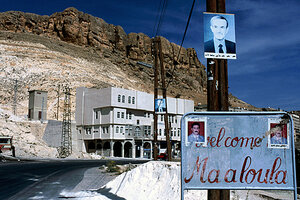Easter Sunday: A Syrian bid to resurrect Aramaic, the language of Jesus Christ
Jesus Christ is remembered on Good Friday and Easter Sunday, but the language he spoke is all but forgotten. A controversial new language institute in Syria seeks to save Aramaic.

The ancient Syrian village of Malula (also spelled Maaloula) is one of only three hamlets where residents still speak the Aramaic of Jesus Christ's day. As Easter Sunday approaches, pilgrims from around the world have been visiting its holy sites and rediscovering the language.
Newscom
Malula, Syria
While millions will commemorate the crucifixion and resurrection of Jesus Christ this Easter Sunday, only a handful of people could discuss his works in the language of his day: Aramaic.
Nearly all of them live in three Syrian villages, the last outposts in a region largely swept by the Arabic of Islam. In a bid to preserve its ancient heritage, Syria launched a series of language courses in 2007 to bolster the fading influence of a 3,000-year-old language that once reigned supreme in the Middle East.
And so it was that an Aramaic institute joined the cluster of buildings that cling to a rocky spine in the village of Malula, about 35 miles northwest of Damascus. But the program ran into trouble recently, when a Syrian newspaper suggested that the alphabet being used to teach written Aramaic bore an uncanny resemblance to the Hebrew characters found in modern-day Israel.
Worried that a flagship heritage scheme might in any way be associated with the country’s neighboring enemy, the government-run University of Damascus, which established the institute, acted quickly to freeze the Aramaic program.
“There were some people in the press trying to cause trouble,” says George Rezkallah, an elderly villager from Malula who runs the institute. He is hopeful that classes will be able to resume this summer.
The origins of Aramaic
Speaking from his flat overlooking the village’s higgledy-piggledy hillside houses, Mr. Rezkallah says that while the two alphabets do have similarities, it is Aramaic which first began using square lettering around the 12th century BC. The Hebrew now used in Israel, he said, was formulated 700 years later after the restoration of the ancient kingdom of the Jews in the 5th century BC.
“The Persians adopted Aramaic. The Babylonians adopted it and so did the Jews. It then prevailed as the language of the Middle East until 700 AD.”
David Taylor, author of "The Hidden Pearl: Aramaic Heritage of the Syrian Orthodox Church," adds that the Jewish people adopted the square Aramaic alphabet – which had become the lingua franca of the entire Middle East from about 700 BC – after they were exiled to Babylon in 587 BC, before which they had used a Palaeo-Hebrew script.
The fact that it has survived in Malula today is nothing short of a “miracle,” says Gene Gragg, professor of Near Eastern Languages at the University of Chicago.
“It would be something of a linguistic tragedy if this splendid survivor were allowed to disappear,” he added.
It would also be a travesty for Syria, says Dr. Taylor.
“Aramaic is a constant reminder of the international importance of Syria in the ancient world, when it was a beacon of learning and culture that had a profound impact worldwide,” he says. “It mirrors the cultural, linguistic and religious diversity that has always been of such great importance in Syria and is key to its long-term success.”
A last remnant of Jesus's language
Modern branches of the language are still spoken across southeast Turkey, northern Iraq, and northwest Iran.
But the dialect spoken by its inhabitants – as well as the residents of two nearby, mostly Muslim, villages – is the only survivor of Western Aramaic, the closest modern descendant to the language spoken by Jesus and his disciples.
It would, in all probability, have been spoken by the Christian martyr St. Thecla, a disciple of St. Paul whose tomb in Malula draws pilgrims from around the world.
“It’s quite extraordinary,” says Annyck Wustyn, a 63-year-old visitor from France. “In our country, where we are mostly Catholic, Aramaic is like a myth. Now I know it is a reality.”
Pushing forward with the program
Undeterred by the move to shut down his Aramaic institute, Rezkallah plans to introduce a new course this summer which, for the first time, will include a textbook using Aramaic to English translations – effectively opening up the institute to non-Arabic speaking students for the first time since it was founded.
According to Rezkallah, the dispute over the Hebrew similarities is still “being discussed,” but the institute has trained an extra nine teachers this year in anticipation of an extension of the program. The new textbook will, however, use Syriac script from the second century BC in lieu of square Aramaic lettering.
For the likes of Atallah Shaib, a young man working in his father’s restaurant overlooking the rickety houses of Malula, the fight to secure his language’s future is as important as ever.
“Aramaic is not a normal language,” says Mr. Shaib, his rolled-up sleeves revealing a series of inky blue Aramaic tattoos on his forearms. “It’s Jesus Christ’s language, and that’s the most important reason why we should keep it alive.”
